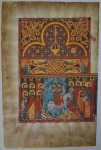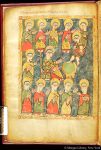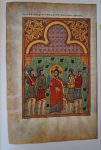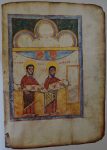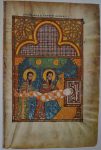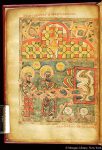Research on BM 1574
Amanda Bolin
The Ethiopian canon is a complex and intricate one, composed of various motifs both imported and local. The Bob McCarthy Manuscript (BM 1574) is such an example of this rich style. It is composed of two sections, one from the fourteenth century, which features various scenes from the Life of Christ, and the other is from the fifteenth century, a Gospel of the Miracles of Mary. The wide date range of MS 1574 allows for a unique examination of the changing cultural and artistic interests of Ethiopia during these periods. In the fifteenth century, the country experienced a religious shift and began the promotion of Marian iconography and texts devoted to her. This instance was brought on by the reign of Zär’a Ya’eqob, as well as his father Emperor Dawit. The manuscript reveals this changing iconography by showcasing scenes from the Life of Christ as well as a Gospel of the Miracles of Mary, each designed with a different style and cultural intention. It is a rich and valuable piece of history connected to a country that is not typically recognized for its artistic endeavors. This analysis has been created in the hopes of promoting the complexities and intricacies of the Ethiopian canon.
The sheer placement of Ethiopia creates iconography that is compiled from a rich cultural matrix composited of motifs from across the Middle East and Mediterranean. BM 1574 is an example of this complex intercultural network. Even the translation of the Bible, during the Axumite period, emerged from Greek texts with portions edited in Syriac.1 Muslim refugees of the Hejaz region from 615 CE remarked on “the beauty of the Cathedral of Axum and the marvels painted upon the walls.”2 Although in later centuries, tensions rose between Muslim and Christian states, early interactions solidified Arabic presence in the Ethiopian artistic canon. Even as Ethiopian artists established a unique national style, iconography from other regions was still utilized. A myriad of other cultures, such as Byzantine style and, appearing in later centuries, European motifs, made their mark on the Ethiopian canon and appear throughout BM 1574.
The manuscript contains no colophon, however, due to the style of script, the object can be dated around the middle of the fifteenth century.3 Emperor Zär’a Ya’eqob (1434-1468) is also named in the prologue of the Miracles of Mary, which was translated into Ge’ez around the year 1436.4 Thus, the manuscript can be marked as being produced sometime after this date.
The manuscript is bound between two wooded boards, which show obvious wear. At some point, the front board split and was bound together by metal staples. This repairs showcases the use that BM 1574 experienced as a religious text, brought out from feast days to liturgies.
In the fourteenth-century portion of the manuscript, most of the scenes are enframed by a trefoil arch with a checkered pattern within and patterning around the outside of the arch done in yellow. It is a richly designed framing device for the various scenes of the Life of Christ.
The first illustrated page displays the Flight Into Egypt, which features the Virgin Mary, Joseph, the Christ Child, and Salome. While the midwife, Salome, is not typically featured in European art and is generally forgotten in the western biblical canon, in the Ethiopian context, she performs a prominent role and was featured in the scene from the thirteenth to seventeenth century.5 In BM 1574, she holds a lantern on the left side of the page and follows the Holy Family as they move to the right towards Egypt. Mary stands in contrapasto with her face wholly visible, while Salome, Joseph, and the Christ Child are designed with a three-quarter profile. A cruciform nimbus distinguishes the Christ Child, while a unique double-lined nimbus defines Mary. The red and blue lattice pattern behind the figures is an interesting inclusion, as it is one of the only known examples of such a background, meant to display the passing landscape as the Holy Family flees in the night.6
The following page folio 2v shows the Baptism of Christ, featuring John the Baptist and two framing angels. While the double-lined nimbus appears again upon the angels, Christ and John receive no nimbi. The Holy Dove is presented directly above Christ as he bathes in the abstracted Jordan River and two fish present in the water swim parallel to each other, each headed a different direction. The image is distinctly similar to that of the Pierpont Morgan Library Manuscript M.828 f10r created in the early fifteenth century, suggesting the continuation of a standardized canon.
The overhanging placement of the angel’s wings suggests a canopy, which correlates to the authority of the Ethiopian imperial court, as rulers were typically presented under an awning.7 While this manuscript does not follow the royal style, it highlights the prevalence of certain motifs, such as the winged canopy, within the common artistic mode. The wings also serve as a visual cue, directing the viewer’s gaze to the holy dove above the scene. This motion is done in conjunction with the pointing fingers of the angels, which direct towards both the dove and the river. John is also presented on the right of Christ, suggesting the modernity of many of the motifs featured in the manuscript, as John the Baptist typically remains to the left of Christ, until the fifteenth century. 8
The Marriage at Cana is represented by the central figure of Christ as he blesses the casks of water presented before him, performing a miracle by turning them into wine. Eight apostles surround him, all in various stages of activity around the page. Jacques Mercier describes the scene as reminiscent of an earlier Arabo-Christian painting that established many of the Ethiopian artistic conventions present in the Marriage at Cana scene.9 Another catalogue attributes the iconography to an Arabic-Muslim style.10 The Pierpont Morgan Library Manuscript M.828 displays the scene in relatively the same style, although Christ is surrounded by nine figures, instead of the BM 1574’s eight figures.
The manuscrupt also has Christ placed in a chair, moved to the left-hand side of the page, as he blesses the water in three-quarters view. In BM 1574, Christ, seated instead on a mat, fully faces the viewer and merely turns his arms to the jugs on the right. In addition to his cruciform nimbus, Christ also bears three red dots, spread across his forehead and cheeks. The markings are identical to those on the Holy Family in Flight into Egypt on folio 2r. Possibly, they can be attributed to the same Arabic-Muslim style as mentioned previously, which would extend to include the red outlines present around the heads and hands of the figures, as well as the markings on the cheeks and forehead.11
It is also worth noting that the blue background of the scene is similar to that of the later folio 4v, which features Christ washing the feet of his apostles, furthermore, the scene also disregards the trefoil arch present in all of the previous illustrations.

Cat. 57 Canon Table (Fragment)
Central Ethiopia
Fourteenth to early fifteenth century
Parchment
34 x 21.9 cm
Institute of Ethiopian Studies, no. 5023a-b
Ethiopian Art: The Walters Art Museum
The following two pages, folio 3v and 4r, are meant to be read in conjunction and feature the spread image of Christ’s Entry in Jerusalem. The trefoil arch returns with the charming addition of several birds which are added in the upper corners as a reference to the trees of paradise as well as that of the Eusebian canon tables.12 At the top of f3v, an inscription notes the subject as “Entry into Jerusalem.”13
On folio 3v, Christ is placed in the center, riding a donkey into the city. There are ten figures present, each with a nimbus, split around Christ with five on each side. The opposite page features two more holy figures, which allows for the interpretation of the presence of the twelve apostles.
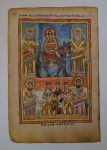
UNESCO PL. II – The Entry into Jerusalem. Addis Ababa Manuscript. (Height of manuscript page: 30 cm).
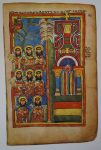
UNESCO PL. III – The Entry into Jerusalem. Addis Ababa Manuscript. (Height of manuscript page: 30 cm).
The image is visually similar to the Kebran Manuscript, due to the iconography present, as well as the Addis Ababa manuscript.14 What is unique to the Bob McCarthy manuscript is the absence of Zaccheus within the scene, who climbed the sycamore tree to see Christ’s approach. A small outline is present in the margin, which could possibly have been the intended location for Zaccheus. As in the Kebran manuscript, Zaccheus would be placed outside of the pictorial border, perched adjacent to the middle tier of the image, which features the rooftops of the city of Jerusalem. However, it must be stated that the outline might simply be a careless marking of the original scribe and not correspond at all to the biblical figure.
Another feature of the scene is the inclusion of two figures in the middle of the page, amongst the rooftops of Jerusalem, who point to Christ. Both the Kebran and the Addis Ababa manuscripts utilize the two figures. However, the latter does contain a description in the right-hand corner, which states “Those who climbed on to the pinnacle of the Temple.”15 Mercier quotes a similar inscription, which identifies the figures as “The two who, at the top of the temple, look at Jesus.” 16 He also acknowledges that the inscription does not correspond with any known text. They are an interesting anomaly unique to the Ethiopian canon.
As the scene is spread across two page, it reveals a particular emphasis placed upon Entry into Jerusalem, as opposed to more theologically important events, furthermore, the use of this double-page spread appears quite commonly in other manuscripts.17 The overall importance of the Entry into Jerusalem scene can correspond to Ethiopian reverence paid to Palm Sunday. Both folio 3v and 4r feature palms spread across the page and are also held by the citizens of Jerusalem.
The following page, folio 4v, shows the Washing of the Feet. As in the Marriage at Cana, the same blue background is utilized and Christ is once again featured in the center. Such recycling is taken further as the chair that Christ sits upon is also reused from one shown in the Marriage at Cana design.
All of the figures are placed in a contrapasto, three-quarters style, with their bodies facing one direction and their heads turned to the viewer. Christ holds the basin he will use to wash his apostles’ feet and displays it, arms stretching to the first apostle. A jug is placed above them. The positions of the object suggest an abstraction of form typical in images of the period. Proportions are ignored and realistic item placement is disregarded for conceptual motifs. It is a canny practice that relies on objectification and understanding of distinct artistic concepts. The designer of the manuscript also utilizes the checkerboard pattern from the trefoil arch on the previous page in the clothing of the top register of apostles, filling in the squares with designed striations or utilizing the vertical lines for decoration in the cloth. It is a charming gesture that features the timelessness of human ingenuity. Lastly, the scene also makes use of the Arabic-Muslim dots upon the cheeks and forehead of Christ.
In many respects, BM 1574 closely follows the Kebran manuscript’s iconography, such as the aforementioned Entry into Jersualem, yet, folio 4v differs through the illustrator’s specific placement of the apostles. Instead,the image more closely relates to the later Pierpont Morgan Library manuscript M.828, fol. 12v. Such a stylistic choice is a break from the Byzantine tradition, which the Kebran manuscript utilizes, and introduces a new prospect into the Ethiopian canon.18
The Washing of the Feet marks the last scene in the 14th century portion of the manuscript before it is divided by the Miracles of Mary illuminations. Folio 5r features a decorated harag and prologue, stating: ‘In the name of the Father, and of the Son, and of the Holy Ghost. One God. We have written this book that us to be read on all Sundays and on all feast days of Our Lady Mary.’19 The following pages are filled with text the Book of Precepts, Mäs’hafa Ser’at, changing on folio 8r to record a liturgy, inserted a much later date, presumably around the nineteenth century. 20
The Miracles of Mary mark a significant change in the Ethiopian artistic canon and can mostly surely be derived from the reign of Zär’a Ya’eqob (1434-1468) and that of his father’s Emperor Dawit (1382-1413). Dawit commissioned the first Miracles of Mary, Taamra Maryam, to enter Ethiopia, translated from Arabic script into Ge’ez, thus beginning the proliferation of the Cult of Mary.21 At his birth, Zär’a Ya’eqob was dedicated to the Virgin Mary in the belief that he was conceived through prayers offered to her.22 There is little information about the time between Dawit’s reign and that of his son, except a succession of four other emperors before the year 1434.23 However, after his coronation, Zär’a Ya’eqob publicly proclaimed, “I am a servant of Mary, the mother of the creator of the world.” 24 He furthered this religious movement by revitalizing the power of both the monarchy and church, through the establishment of more churches and monasteries, as well as, a standardization of religious practice.25 To accomplish this, the emperor deemed veneration to the Marian icon mandatory in the 1440s.26 Thus, the Cult of Mary, formed by the two emperors, spurred an artistic movement that would define the Ethiopian canon for hundreds of years after their reign.
For this reason, the McCarthy manuscript is a valuable example of Ethiopian history, as it supplies iconography present both before and during the rule of Zär’a Ya’eqob. The artistic vocabulary is drastically different than the one shown in the fourteenth century portion of the object. The figures are larger and more abstracted. The illustration is held within a yellow border and is no longer topped by the patterned trefoil arch shown previously. Unfortunately, the images within the Miracle of Mary are not as well preserved as those in the previous sections with much of the paint faded or rubbed away entirely in some locations.
The first illustration appears on folio 10r and features three tiers of the Old Testament prophets, counting fifteen in total.27 One saint on the left side of each row faces the rest of the four saints on the right, while they in turn face the first saint on the left. The inscriptions are largely faded and illegible, although some can be identified, such as Moses, Elias, Daniel, Jeremiah, and Solomon.28 There is also a small inscription on the bottom tier.
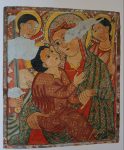
Cat. 20 Fre Seyon Our Lady Mary with Her Beloved Son and Archangels Michael and Gabriel Ethiopia (Tegray), 1445-80
Tempera on panel
(58.4 x 57.8 cm)
IL 1994.4, on loan from a private American collection
Ethiopian Art: The Walters Art Museum
The following illustrations feature two saints on horseback spread across folios 10v and 11r. The one on folio 11r can be clearly identified as Saint George, as a dragon twists beneath his horse’s legs. He thrusts a spear into the beast and regards the viewer in a three-quarter pose. An inscription in his nimbus would also have identified him, however, it has since faded. The horse and its livery are richly decorated and Saint George is equally as fine-robed. The windmill-esque motifs present in the image correspond to patterning by the Fre Seyon School, as seen in an image of “Our Lady Mary with Her Beloved Son” where her clothing is patterned with a similar symbol.29 In a visual sense, the iconography present within the image is highly similar to other scenes of Saint George around the period. The entwinement of the serpent’s tail around the back leg of Saint George’s horse is also a common motif. A lack of wings upon the dragon can also be used for dating purposes, as only the work of Nicolò Brancaleon (ca. 1480-1526) brought winged dragons into the Ethiopian artistic tradition.30 The lack of such a motif further cements the manuscript chronologically as during the reign of Zär’a Ya’eqob.

Cat. 103 Equestrian Saints Gondar, late seventeenth century Parchment (10 x 108 cm) Institute of Ethiopian Studies, no. 3554
Folio 10v shows the image of Saint Claudius, occasionally written as Gälawdyos. It is interesting to note that in another depiction of saints on horseback much later in the seventeenth century, both Claudius and George were pictured together in the same order as presented in the McCarthy manuscript.31 While Claudius is typical to the Ethiopian canon, his appearance is relatively unknown in European practice. His appearance in BM 1574 alludes to the wide variety of saints venerated in Ethiopia, many of which unknown outside of the country. The image of the saint on horseback was one with specific appeal as only nobles were trained in horsemanship and would have garnered interest in a society as socially stratified as Ethiopia.32 The image was also thought to carry apotropaic qualities, similar to such depictions in the Late Antiquity and early Byzantine periods.33 Such a background would give cause to BM 1574 to contain the three pages of saints on horseback.
Folio 11v is identified as Saint Theodore 34 He is still upon a horse with a spear thrust downward, utilizing the same model was used as in folio 10r, minus the serpent. The animal also features colored striations, giving the appearance of a shaggy pelt. As there are only minor differences between folios 10r and 11v, it suggests a specific artistic vocabulary utilized in illustrations of saints on horseback in Ethiopia.
In a notion similar to folio 4v, the artist also makes use of carved lines already present on the vellum and integrates it with the clothing design style. In preparation for the manuscript, vellum was typically lined in large batches, as such, pages would not always bear text and lined folios would be used in illustration.
Folio 12r shows two scenes. The top register displays Christ’s Ascension, while the four evangelists in human form circle around him. The bottom image features Christ’s Circumcision with Salome and a priest identified as Gäbärihuni Zentu.35 This folio page is the first to show Christ in the second portion of the manuscript and the changes to iconography are clearly apparent with the cruciform nimbus designed much differently than in previous pages. Salome’s appearance at the circumcision of Christ is a unique motif, as normally it is the Virgin Mary who is shown with the Christ Child.As seen on folio 2r, images of Salome are typically restricted to scenes of the Nativity or Flight into Egypt.
Nevertheless, the Circumcision retains a valuable role in the Ethiopian Orthodox Church, with a feast day on the 6th of Terr (January 13), and it is presented accordingly in the manuscript, with the high priest poised with the knife. During the fourteenth and fifteenth centuries, the scene became popular in European and Venetian painter studios.36 During Za’ra Yaqob’s reign, the Emperor sent delegates to the Council of Florence.37 Perhaps it was upon the delegates’ return to Ethiopia that the Crucifixion scene entered the artistic mode. By 1453, with the capture of Constantinople by the Turks, Ethiopia’s importance in trade grew in European eyes and presumably artistic motifs were exchanged.38 Thus such factors could very well have played into the importance of a circumcision scene within the Ethiopian canon.
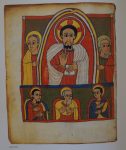
Cat. 14 Gospel Book Folio 59v Ethiopia (Gunda Gunde), early-mid-16th century Tempera and ink on parchment, bare wooden end boards (30 x 25.4 cm), 211 ff. W.850, museum purchase, the W. Alton Jones Foundation Acquisition Fund, 1998
Yet Christ in Majesty appearing on the same page as the Circumcision is an unusual and slightly anachronistic placement, especially as other scenes from the Life of Christ are shown amongst the following folios, such as the Baptism, Nativity, as well as the Crucifixion. Furthermore, the Circumcision and Christ in Majesty do not typically appear on the same page in European works, if such a scene is to be an extension of European and Ethiopian trade. A reasonable explanation can possibly emerge if the image of the Circumcision is meant to relate to the missing scene of the Presentation in the Temple, then perhaps the quintessential image of the power of the heavenly Christ is not so far a stretch to make. As Christ comes into his power through the Presentation in the Temple, he also reveals himself in a form of ultimate power, the Ascension. The pose of the four evangelists play with this theme as well, as their pulling back on the oval surrounding Christ references the reveal of his divinity, as seen in an image featuring the motif in the later 16th century.39 Such imagery poses only to further cement the connection from the image of the Circumcision to the eventual fate of Christ as a divine and heavenly figure.
The image on folio 12v alludes to the fate of Christ with the first Crucifixion image in the manuscript. It is later followed by the 14th-century portion which also contains a Crucifixion. However, the scene is designed with drastically different artistic priorities than the image presented on folio 12v. Here, the body of Christ dominates the page, flanked by the the two thieves, and blood flows from his stigmata; however, the wounds are not rendered, suggesting an appeal for the preserved body of Christ.
Uniquely, John the Baptist appears in the scene, shown opposite of the Virgin Mary. In the Western tradition, it is typically John the Evangelist that appears around the image of the Crucifixion, not John the Baptist and his appearance on folio 12v reveals an unique difference within the Ethiopian artistic canon. It is also interesting to note that although the manuscript focuses on the Miracles of Mary, this is the first illustration in which she appears, thus connecting her intimately with the fate of Christ.
However, some motifs are heavily standardized, as the scene also contains classical imagery such as the appearance of the Sun and Moon, although the representation is not anthropomorphized and is instead depicted only through blue and red circles.
The following page, folio 13r, shows the twelve apostles split into three rows composed of four figures. They are titled as follows from left to right: John, James (brother of Christ), Andrew, Phillip, Bartholomew, Peter, Paul, Thadeus, Nathaniel, Thomas, Matthew, and James.40 The relatively intact Ge’ez in the nimbus of each saint serves to identify each person, as they hold no recognizable attributes to aid in identification, except for Peter, shown in the middle row, who does carry what can be interpreted as an attenuated key. The rest seem to hold white squares, possibly relating to the word of God and the teachings of Christ.
The next image cycle is once more combined, as seen on folio 12r, and shows the unique addition of both the Baptism of Christ and the Nativity. The page is broken into four paneled segments; the top two reveal the Baptism, and the two below show the Nativity. John the Baptist breaks through the created border by placing his hand atop Christ’s head. The flow of the Jordan river around Christ correlates to a pattern beneath John, as if the original design was for both men to be submerged in water. The holy dove is seen in the upper left corner, shown in its own smaller square. While the scene utilizes a different artistic vocabulary, the motifs are similar to the earlier Baptism on folio 2v, only the angels and fish are missing from the 15th-century representation. However most auxiliary details are cut from the manuscript’s later interpretations of the Life of Christ, which might explain the absence of the aforementioned motifs.
The bottom register Nativity image shows both Salome and the Virgin Mary; Joseph is missing from this depiction, as well as any animals. A unique element that appears on this page is the use of the double-lined nimbus, previously only used in portions of the fourteenth-century section of the manuscript. The specific nimbus is used only on the Virgin Mary and the John the Baptist placed directly above her. The repeating motif is an interesting example of the continuation of certain iconography, from what was once considered an archaic element to being utilized to distinguish particular figures.
In the next image, the Virgin Mary is presented with the suckling Christ Child and flanked by two angels with swords raised. On folio 14r, the Christ is perched on Mary’s right arm, but other Ethiopian images differ, suggesting that the positioning was by no means standard. 41 Of course, the scene of the nursing Virgin and Child does not typically appear in Ethiopia until the mid-fifteenth century, therefore some ambiguity around the placement of the Christ Child is expected due to the relative novelty of the scene.42 Christ also does not give a gesture of benediction, as compared to earlier models, which helps suggest a date in the early fifteenth century, before such a gesture became common.43 It also reveals a separation from the Byzantine model, which typically placed the Christ Child on the Virgin’s left side.44 The artist also employs the winged canopy as seen on folio 2v, featuring the Baptism of Christ. Although the full wing is not visible in folio 14r, it follows within the traditional representation of the Ethiopian Virgin and Child.The use of the armed angels is also highly unique to Ethiopian art, as practically every depiction of the scene features the Virgin flanked by the two figures.
The final page of the fifteenth-century portion of the manuscript, folio 14v, is an interesting one. Interpretations attribute the scene as the containing the Virgin Mary in the top register, between Christ and Täklä Haymanot, and in the bottom register, featuring a king between two women.45 It has suffered much erosion and fading, leaving many of the once identifiable inscriptions now largely illegible. The king could possibly be the figure of Zär’a Ya’eqob, as his headgear is typical for rulers of the period; however, a lack of inscription prevents any sure identification.46 Every figure, but the king, wears a nimbus. However, the cruciform nimbus which typically identifies Christ is absent in the image, although it might have once been present and is currently too faded to recognize.
Folio 15r marks a return to the fourteenth century portion of the manuscript with the Arrest of Christ. The image follows with the basic pattern found in other manuscripts, such as the Pierpont Morgan Library manuscript, with Christ and the soldiers occupying the same positions and holding the same objects. In a unique twist, BM 1574 chooses to show every figure in three-quarter view, ignoring the Ethiopian convention of displaying ‘evil’ characters in profile as to omit the evil eye.47
For example, the Kebran Manuscript, which shares many similarities to the McCarthy object, chooses to display the soldiers in this side-profile. An Islamic influence is attributed to be responsible as the BM 1574 soldiers wear turbans, however, the soldiers in the Kebran Manuscript don them as well.48 Such a motif reveals the intricacies of the Ethiopian canon and the flux that much of the iconography encountered, before settling upon an eventual standard.

Cat. 107 Octateuch, Four Gospels, and Synodicon Repentance of Peter Gondar (?), late seventeenth century Parchment: stamped, leather-covered wood end boards (36.8 x 35.4 cm), 209 ff. British Library, Or. 481
The background is also an abstraction of the gardens along the Mount of Olives and is repeated in the next page, folio15v, which shows the Repentance of Peter. 49 The Virgin Mary and John also appear, both oddly veiled. In a much later example, the seventeenth-century folio page from the Four Gospels, found in the Octateuch, Four Gospels, and Synodicon manuscript, also features John veiled and standing next to Mary, which suggests a long-standing artistic convention to present the figure in such a manner. Interestingly, the covered hands of Peter are repeated in both images, a feature that does not typically appear in the European artistic canon.
Folio 16r reveals the second image of the Crucifixion, enacted with a drastically different artistic vocabulary than that on folio 12v. Most notably, Christ appears not in corpus, but instead as the Lamb of God. This particular motif emerged as pilgrims returned from Jerusalem in the sixth century carrying ampullae displaying an empty cross, which was also accompanied by a bust of Christ.50 The tradition of a cross without the figure of Christ emerged from these tourists’ objects and was sustained in Ethiopia. The cult of the Cross of Life is also responsible for such iconography, with its belief in the sanctity of the cross and its ability to preserve life, not destroy it.51 Thus, Christ could not appear injured on the cross, so the imagery was subverted through the placement of the Holy Lamb. Otherwise, the image closely follows the traditional Byzantine model, with the appearance of the two thieves and spear bearers, as well as the classical anthropomorphic sun and moon.
Two mounds seem to emerge from behind the crosses of the thieves, on a line stretching across the page from the horizontal point of the middle cross. The appearance of such a motif is a possible correlation to the Rabbula manuscript, in which the mounds represent the flanking hills around Golgotha, the site where Christ was crucified. 52
Text on the page, surrounding the lamb, reads: “Behold the Lamb of God who takes away the sin of the world.”53 The phrasing excludes Christ, further cementing the sanctity of the Cross and its inability to maim the body of Christ.
Lastly, the placement of the Repentance of Peter, featuring both Mary and John moving to the right, next to the image of the Crucifixion, seems almost an attempt to merge the European tradition with the traditional Ethiopian style. Typically, both Mary and John are present in the Crucifixion, but the Ethiopian artistic convention removes them from the scene. The two folio pages create a spread, moving the figures of both John and Mary into the Crucifixion image, without explicitly placing them there. The action at least suggests one of the early stages as the traditions merged.
The Entombment follows on folio 16v, featuring Joseph of Arimathea and Nicodemus, the enshrouded body of Christ, and an inscription above the sleeping soldiers stating: “those who are set to watch….”54 The scene reveals a departure from the Byzantine tradition by removing the Virgin and other holy women and keeping only the two apostles.55 The most curious element of the scene is that of the two yellow circular disks suspended in the background. They correspond to the sun and moon in the previous Crucifixion scene, however, the motif makes appearances in other images of the Entombment, examples include: the Kebran Manuscript, Jahjah Giyorgis Manuscript, as well as the Pierpont Morgan Library Manuscript, which also feature the same circular, occasionally anthropomorphized, disks as on folio 16v. The wide date ranges of these objects suggest that the two disks became an important motif in the image of the Entombment and something that must be included when all other extraneous details were removed.
The next scene is the Resurrection of Christ, identified by the inscription stating: “where our Lord resurrected.”56 It features five figures, two women, two men, and one angel, all with nimbi. The rightmost figure, the angel, brings word of Christ’s resurrection to the figures before him. However, unlike typical depictions of the Resurrection, Christ does not make an appearance in this image.
In his place is the Virgin Mary, as seen in the similar iconography of the Pierpont Morgan Library Manuscript, which identifies those present as Peter, John the Evangelist, Mary Magdalene, the Virgin Mary, and the Archangel Michael.57 The use of the Virgin Mary can possibly be explained as a method of uniting two opposing artistic canons in Ethiopia. One displayed the image of the Holy Women at the Tomb (UNESCO, PL. XX.), while the other chose the Announcement of the Resurrection. In BM 1574, these two artistic modes are cleverly combined. The scene also has the theatrical effect of drawing out the revelation of the resurrected Christ, who appears in the last image of the manuscript on folio 17v in the Ascension.
The image of the Ascension is a recognizable motif, akin in popularity to the Crucifixion. It is an integral part of the Christian story and is even recognized as one of the three images consistently shown in short cycle, which displays the Crucifixion, Resurrection, and the aforementioned Ascension.58 The manuscript utilizes all the motifs necessary to accompany the scene, such as: the twelve apostles, the Virgin Mary, the four evangelists, and the image of Christ in Majesty framed within his mandorla. The Raboula, Syriac Manuscript, created in the year 586, was the first to display the motifs listed above and the image has changed little since.59 Only the appearance of the evangelists, or the four heavenly animals as termed in Ethiopian tradition, differs from the original composition.60The apostles point upwards and to the center, directing the viewer’s attention to the scene happening above and to the Virgin. Mary, in the center, raises both hands towards the Ascension of Christ. She also wears the double-line nimbus and her placement in the image is almost identical to her presentation on the first illustrated folio page, serving as a sort of bookend to the Life of Christ chronicle.
The rest of manuscript describes the Miracles of Mary, of which there are one hundred and fifteen in total, the Praises of Mary, Weddasê Maryam, the Revelation of the Miracle, Ra’eyyä Tä’ammer, and lastly, the Anaphora of Mary.61 The object is also attributed to the original owners through a blessing on folio 216r-v, directed towards Gäbra Mär’awi and his wife Emnä S’eyon.62
In summary, BM 1574 is a rare portion of the Ethiopian artistic canon, displaying a variety of religious images dated from both before and after the Cult of Mary and the reign of Zär’a Ya’eqob. The manuscript raises questions on the origin of iconography, the spread of certain religious movements, as well as the effects of various artistic styles across Ethiopia. Overall, the manuscript is a sprawling piece of artistry, which often raises more questions than answers. Yet, its place in the Ethiopian artistic canon is clearly defined and utilized, marking it definitively as a valuable object for study.


